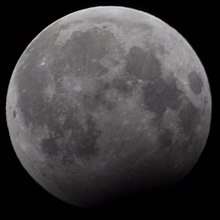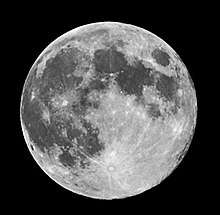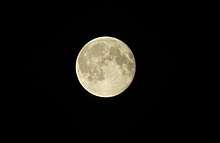Blue moon
A blue moon is an additional full moon that appears in a subdivision of a year: either the third of four full moons in a season, or a second full moon in a month of the common calendar.

The phrase in modern usage has nothing to do with the actual color of the Moon, although a visually blue Moon (the Moon appearing with a bluish tinge) may occur under certain atmospheric conditions – for instance, if volcanic eruptions or fires release particles in the atmosphere of just the right size to preferentially scatter red light.[1]
Definition
The term has traditionally, in the Maine Farmer's Almanac, referred to an "extra" full moon, where a year which normally has 12 full moons has 13 instead. The "blue moon" reference is applied to the third full moon in a season with four full moons,[2] thus correcting the timing of the last month of a season that would have otherwise been expected too early. This happens every two to three years (seven times in the Metonic cycle of 19 years).[3] The March 1946 issue of Sky & Telescope misinterpreted the traditional definition, which led to the modern colloquial misunderstanding that a blue moon is a second full moon in a single solar calendar month with no seasonal link.
Owing to the rarity of a blue moon, the term "blue moon" is used colloquially to mean a rare event, as in the phrase "once in a blue moon".[4][5]
One lunation (an average lunar cycle) is 29.53 days. There are about 365.24 days in a tropical year. Therefore, about 12.37 lunations (365.24 days divided by 29.53 days) occur in a tropical year. In the widely used Gregorian calendar, there are 12 months (the word month is derived from moon[6]) in a year, and normally there is one full moon each month. Each calendar year contains roughly 11 days more than the number of days in 12 lunar cycles. The extra days accumulate, so every two or three years (seven times in the 19-year Metonic cycle), there is an extra full moon. The extra full moon necessarily falls in one of the four seasons, giving that season four full moons instead of the usual three, and, hence, a blue moon.
- In calculating the dates for Lent and Easter, Catholic clergy identified a Lenten moon. Historically, when the moons arrived too early, they called the early moon a "betrayer" (belewe) moon, so the Lenten moon came at its expected time.
- Folklore named each of the 12 full moons in a year according to its time of year. The occasional 13th full moon that came too early for its season was called a "blue moon", so the rest of the moons that year retained their customary seasonal names.
- The Maine Farmers' Almanac called the third full moon in a season that had four the "blue moon".
- The frequency of a blue moon can be calculated as follows. It is the period of time it would take for an extra synodic orbit of the moon to occur in a year. Given that a year is approximately 365.2425 days and a synodic orbit is 29.5309 days,[7] then there are about 12.368 synodic months in a year. For this to add up to another full month would take 1/0.368 years. Thus it would take about 2.716 years, or 2 years, 8 months and 18 days for another blue moon to occur.
- Using the common Sky & Telescope misunderstanding, when one calendar month has two full moons; the second one is called a "blue moon". On rare occasions in a calendar year (as happened in 2010 in time zones east of UTC+07), both January and March each have two full moons, so that the second one in each month is called a "blue moon"; in this case, the month of February, with only 28 or 29 days, has no full moon. Under this misinterpretation a blue moon can be more frequent.
Origin of the term

The earliest recorded English usage of the term blue moon is found in an anti-clerical pamphlet (attacking the Roman clergy, and cardinal Thomas Wolsey in particular) by two converted Greenwich friars, William Roy and Jerome Barlow, published in 1528 under the title Rede me and be nott wrothe, for I say no thynge but trothe. The relevant passage reads:[8]
O churche men are wyly foxes [...] Yf they say the mone is blewe / We must beleve that it is true / Admittynge their interpretacion.[9]
It is not clear from the context that this refers to intercalation; the context of the passage is a dialogue between two priest's servants, spoken by the character "Jeffrey" (a brefe dialoge betwene two preste's servauntis, named Watkyn and Ieffraye). The intention may simply be that Jeffrey makes an absurd statement, "the moon is blue", to make the point that priests require laymen to believe in statements even if they are patently false.
'Betrayer moon' speculation
In 2007, Joe Rao, Skywatching Columnist at Space.com, stated that many years previously he had speculated in Natural History magazine that the "Blue Moon Rule" might derive from 'belewe', which he described as an Old English word meaning 'to betray', because the extra full moon "betrays the usual perception of one full moon per month."[10] He then added that his speculation had been "innovative", but "completely wrong".[10] In 2009 a less detailed version of this speculation was mentioned in Farmers' Almanac.[11] The website www.oldenglishtranslator says that the word 'belæwe' (as distinct from 'belewe') is a form of the Old English verb 'belæwan' ('to betray').[12]
Maine Farmers' Almanac blue moons
In the 19th and early 20th centuries, the Maine Farmers' Almanac listed blue moon dates for farmers. These correspond to the third full moon in a quarter of the year when there were four full moons (normally a quarter year has three full moons). Full moon names were given to each lunation in a season. The seasons used were those of the mean tropical year, equal in length, as opposed to the astronomical seasons which vary in length because the earth's speed in its orbit round the sun is not uniform.
To compare, in 1983 the equal seasons began at 1.48 AM on 23 March, 9.15 AM on 22 June, 4.42 PM on 21 September and 12.10 AM on 22 December, while the astronomical seasons began at 4.39 AM on 21 March, 11.09 PM on 21 June, 2.42 PM on 23 September and 10.30 AM on 22 December (all times GMT). When a season has four full moons the third is called the "blue moon" so that the last can continue to be called with the proper name for that season.[2]
Sky and Telescope calendar misinterpretation
The March 1946 Sky and Telescope article "Once in a Blue Moon" by James Hugh Pruett misinterpreted the 1937 Maine Farmers' Almanac. "Seven times in 19 years there were – and still are – 13 full moons in a year. This gives 11 months with one full moon each and one with two. This second in a month, so I interpret it, was called Blue Moon." Widespread adoption of the definition of a "blue moon" as the second full moon in a month followed its use on the popular radio program StarDate on January 31, 1980[2] and in a question in the Trivial Pursuit game in 1986.[5]
Visibly blue moon

The most literal meaning of blue moon is when the moon (not necessarily a full moon) appears to a casual observer to be unusually bluish, which is a rare event. The effect can be caused by smoke or dust particles in the atmosphere, as has happened after forest fires in Sweden and Canada in 1950 and 1951,[13] and after the eruption of Krakatoa in 1883, which caused the moon to appear blue for nearly two years.[14] Other less potent volcanoes have also turned the moon blue. People saw blue moons in 1983 after the eruption of the El Chichón volcano in Mexico, and there are reports of blue moons caused by Mount St. Helens in 1980 and Mount Pinatubo in 1991.[15] In the Antarctic diary of Robert Falcon Scott for July 11, 1911 his entry says, "... the air thick with snow, and the moon a vague blue".[16] On that date the moon phase would have looked full.
On September 23, 1950, several muskeg fires that had been smoldering for several years in Alberta, Canada, suddenly blew up into major—and very smoky—fires. Winds carried the smoke eastward and southward with unusual speed, and the conditions of the fire produced large quantities of oily droplets of just the right size (about 1 micrometre in diameter) to scatter red and yellow light. Wherever the smoke cleared enough so that the sun was visible, it was lavender or blue. Ontario, Canada, and much of the east coast of the United States were affected by the following day, and two days later, observers in Britain reported an indigo sun in smoke-dimmed skies, followed by an equally blue moon that evening.[15][17]
The key to a blue moon is having lots of particles slightly wider than the wavelength of red light (0.7 micrometer)—and no other sizes present. It is rare, but volcanoes sometimes produce such clouds, as do forest fires. Ash and dust clouds thrown into the atmosphere by fires and storms usually contain a mixture of particles with a wide range of sizes, with most smaller than 1 micrometer, and they tend to scatter blue light. This kind of cloud makes the moon turn red; thus red moons are far more common than blue moons.[18]
Blue moons between 2009 and 2021
The following blue moons occur between 2009 and 2021. These dates use UTC as the timezone; exact dates vary with different timezones.
Seasonal
Using the Maine Farmers' Almanac definition of blue moon (meaning the third full moon in a season of four full moons, but referenced to astronomical rather than equal seasons), blue moons have occurred or will occur on:
- November 21, 2010
- August 20, 2013
- May 21, 2016
- May 18, 2019
- August 22, 2021
Calendar

Unlike the astronomical seasonal definition, these dates are dependent on the Gregorian calendar and time zones.
Two full moons in one month (the second of which is a "blue moon"):[19]
- 2009: December 2 and 31 (partial lunar eclipse visible in some parts of the world), only in time zones west of UTC+05.
- 2010: January 1 (partial lunar eclipse) and 30, only in time zones east of UTC+04:30.
- 2010: March 1 and 30, only in time zones east of UTC+07.
- 2012: August 2 and 31, only in time zones west of UTC+10.
- 2012: September 1 and 30, only in time zones east of UTC+10:30.
- 2015: July 2 and 31.
- 2018: January 2 and 31, only in time zones west of UTC+11.
- 2018: March 2 and 31, only in time zones west of UTC+12.
- 2020: October 1 and 31, only in time zones west of UTC+10.
The next time New Year's Eve falls on a Blue Moon (as occurred on December 31, 2009 in time zones west of UTC+05) is after one Metonic cycle, in 2028 in time zones west of UTC+08. At that time there will be a total lunar eclipse.
Popular culture
Blue moons have been referenced in popular culture.
Music
"Blue Moon" is a popular music standard, written by Richard Rodgers and Lorenz Hart in 1934,[20] and one of the best known football chants,[21] used since the '90s by Manchester City and Crewe Alexandra.[22] "Once in a Very Blue Moon" is a song written by Patrick Alger, recorded by Nanci Griffith, and released on her 1984 LP of the same name. "New Blue Moon", released in 1990, was a song written and recorded by the Traveling Wilburys. There are more modern songs, like Beck's 2014 "Blue Moon."[20][23] South Korean rock band CN Blue named their 2013-2014 concert tour "Blue Moon World Tour."[24] "Blue Moon of Kentucky" is a bluegrass standard, written in 1946 by Bill Monroe.
Books
In the 1998 paranormal romance fiction novel by Laurell K. Hamilton of the same name, Blue Moon refers to two full moons occurring within the same month.[25] In the 2009 young adult fiction novel by Alyson Noël of the same name, Blue Moon refers to two full moons occurring within the same month and the same astrological sign.[26] Note that if two full moons fall within the same astrological sign they will fall in different calendar months, and vice versa. In the novels of Simon R. Green the blue moon plays a significant magical role, and also figures in titles of three of his novels: Blue Moon Rising, Beyond the Blue Moon, and Once in a Blue Moon, all of the Hawk & Fisher fantasy series.
Films and television
The Moon Is Blue, a 1953 movie starring William Holden, was nominated for three Oscars.[27] Blue Moon Investigations is the name of the detective agency in the TV series Moonlighting starring Cybill Shepherd and Bruce Willis.[28] A Blue Moon appears as a significant element in the 2011 film The Smurfs,[29] and the Wikipedia page on Blue Moon is viewed in the movie. The Smurfs TV show also featured the blue moon in an episode.[30] The theme song for The Sopranos, "Woke Up This Morning" by Alabama 3, references "a blue moon in your eyes" in its lyrics. "Once in a Blue Moon" is also the name of an episode of TV show Charmed, which involves the three witches being affected by the blue moon magically, and turning into monsters.[31]
Video Games
Blue moon is the name of a country in Nintendo's Advance Wars series.
See also
- Black moon
- Blood moon
- Wet moon
References
- Gibbs, Philip (May 1997). "Why is the sky blue?". math.ucr.edu. Retrieved November 4, 2015.
... may cause the moon to have a blue tinge since the red light has been scattered out.
- Sinnott, Roger W.; Olson, Donald W.; Fienberg, Richard Tresch (May 1999). "What's a Blue Moon?". Sky & Telescope. Retrieved September 1, 2012.
The trendy definition of 'blue Moon' as the second full Moon in a month is a mistake.
- Plait, Phil. "Today's Full Moon is the 13th and Last of 2012".
- Smith, Bridie (December 28, 2009). "Once in a Blue Moon ..." The Age. Retrieved September 1, 2012.
- Hiscock, Philip (August 30, 2012). "Folklore of the 'Blue Moon'". International Planetarium Society.
- "Month | Define Month at Dictionary.com". Dictionary.reference.com. Retrieved August 25, 2013.
- Espanek, Fred. "Eclipses and the moon's orbit". NASA. Retrieved March 10, 2016.
- printed by John Schott at Strasburg in 1528. See also Koelbing, Arthur (1907–21). "Barclay and Skelton: German Influence on English Literature". In A.W. Ward; et al. (eds.). The Cambridge History of English and American Literature. New York: G.P. Putnam's Sons. vol. III, ch. 4, § 14. ISBN 1-58734-073-9.
- ed. Arber 1871 p. 114
- Joe Rao, Space.com Skywatching Columnist (May 25, 2007). "The Truth Behind This Month's Blue Moon". Space.com. Retrieved July 28, 2018.
- "What Is a Blue Moon?". Farmers' Almanac. Almanac Publishing Co. August 24, 2009. Archived from the original on September 7, 2012. Retrieved September 1, 2012.
- "Old English to Modern English Translator". www.oldenglishtranslator. Retrieved July 28, 2018. Translating the word 'belæwe' to modern English brings up the verb 'belæwen', translated as 'to betray', and showing 3 of its cases as 'belæwe' (Present tense singular of imperative, subjunctive and 1st person indicative cases). Translating the word 'belewe' to modern English gives 'No word found'.
- Minnaert, M: "De natuurkunde van 't vrije veld" 5th edition Thieme 1974, part I "Licht en kleur in het landschap" par.187 ; ISBN 90-03-90844-3 (out of print); also see ISBN 0-387-97935-2
- Philip Hiscock (August 24, 2012). "Once in a Blue Moon". Sky & Telescope. Retrieved May 27, 2019.
- Blue Moon Archived March 23, 2010, at the Wayback Machine. science.nasa.gov (July 7, 2004).
- Scott Lingley (July 28, 2015). "The year the sun turned blue". Phys.org. Retrieved May 27, 2019.
- Bowling, S. A. (1988-02-22). Blue moons and lavender suns Archived March 21, 2012, at the Wayback Machine. Alaska Science Forum, Article #861
- Giesen, Jurgen. "Blue Moon". Physik und Astromonie. Retrieved January 17, 2009.
- Joffe, Justin (July 31, 2015). "The Blue Moon's Rich History in American Music". The New York Observer. Retrieved September 3, 2015.
- Keidel, Phil (September 18, 2013). "20 Chants Every True Manchester City Fan Should Know". Bleacher Report. Retrieved September 3, 2015.
- Brobyn, Emily (March 9, 2011). "Blue Moon Significance". Retrieved September 3, 2015.
- Grow, Kory (January 20, 2014). "Beck Admits He's 'Tired of Being Alone' in New Song 'Blue Moon'". Rolling Stone. Retrieved September 3, 2015.
- Bae, Soo-min (March 4, 2013). "CNBLUE unveils 2013 BLUE MOON World Tour". Korea Herald. Retrieved February 22, 2014.
- Hamilton, Laurell (1998). Blue Moon. New York City: Ace Books. pp. Ch. 46. ISBN 0-441-00574-8.
- Noël, Alyson (2009). Blue Moon. New York: St. Martin's Griffin. pp. Ch. 37. ISBN 0-312-53276-8.
- "The Moon Is Blue (1953)". IMDb. Retrieved August 8, 2015.
- "Moonlighting Show Summary". TV.com. Retrieved September 3, 2015.
- Moore, Roger (July 29, 2011). "Smurfs in 3-D? Not as scary as you might think". Chicago Tribune. Retrieved September 3, 2015.
- "The Smurfs Season 3 Episode 1 Once In A Blue Moon". TV.com. Retrieved September 3, 2015.
- "Charmed Season 7 Episode 6: Once in a Blue Moon". TV.com. Retrieved September 3, 2015.
External links
- Information about the August 2012 Blue Moon
- "Folklore of the Blue Moon" by Philip Hiscock
- "What's a Blue Moon?" by Donald W. Olson, Richard T. Fienberg, and Roger W. Sinnott, Sky & Telescope. Article explaining that originally a blue moon meant the 3rd full moon in a season of 4 full moons, and how the "2nd in a month" error began.
